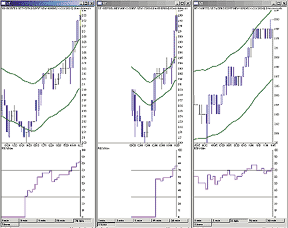Making The Days Count
Strategies For Daytrading
by Jacob Singer
These strategies could improve your daytrading.
Trading strategies that fall under the definition of daytrading can be confusing, because there are really three types of daytrading: intraday trading, end-of-day trading, and daytrading. The three kinds are similar, but there are clear distinctions.
1. Intraday trading is when a trader makes a large number of trades in a single day, taking a one- or two-point profit and trading both short and long positions as the market changes direction during the day. The objective is to have all of these small trades add up to a good profit at the end of the day. Positions are always closed out before the market closes. This type of trading can only be done when commissions charged per trade are very small.2. End-of-day trading occurs when a trader takes a position in the morning as the market opens, and once a fill is received, places a target level to close the position. The trader places a stop-loss in case the position moves against him or her, and closes all open positions at the end of the day.
3. Daytrading is similar to end-of-day trading, but positions can be held overnight. This is because the first 15 to 20 minutes of trading in the morning usually follow the trend of the last 15 to 20 minutes before the previous day's close. The daytrader takes a position during the day, planning to close out either that day or the following one, whenever his trading target is met. He will watch the position over the one or two days, all the while adjusting his stop-loss and allowing his profits to ride.
Daytrading companies flourished at the height of the market bubble in the year 2000. Anyone with a personal computer and a minimum of $25,000 in capital could start trading for themselves, whether at home or in special trading rooms at daytrading companies. These companies gave the new traders preliminary lessons on how to read technical charts and market-depth tables. They were introduced to a simple technical strategy, usually a program offered by the daytrading company, and most important, they were taught which buttons to press on the keyboard and how often.

Figure 1: Charts of different periodicities. Here you see a 30-minute, 60-minute, and five-minute chart of Nortel Networks (NT). Overlaid on the chart is a 28-period moving average band, and in the subchart, a 10-period RSI.
As the bull market rushed on from 1999 to 2000, many of those daytraders made a great deal of money, and even gave up their normal jobs to pursue the life of the intraday trader. But when the bubble burst, and during the bear market that followed, most of those daytraders lost their capital and gave up trading. Many trading rooms vanished in mergers or closed completely. But is daytrading really dead? Those who survived and learned from their experiences honed their skills on the whetstone of those bubble years. They became professional, profit-making intraday and daytraders.
...Continued in the August 2003 issue of Technical Analysis of STOCKS & COMMODITIES
Excerpted from an article originally published in the August 2003 issue of Technical Analysis of STOCKS & COMMODITIES magazine. All rights reserved. © Copyright 2003, Technical Analysis, Inc.
Return to August 2003 Contents